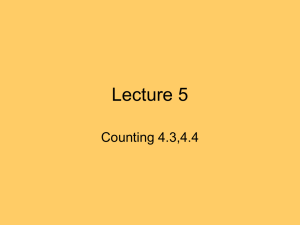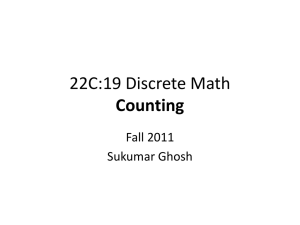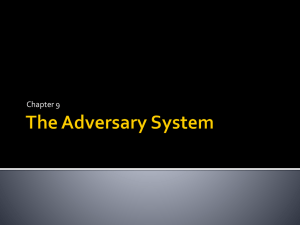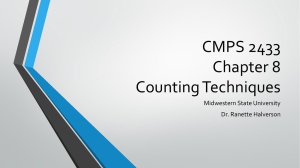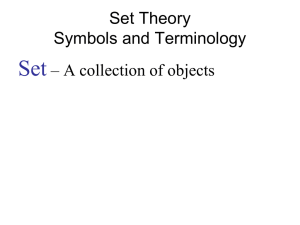slides
advertisement
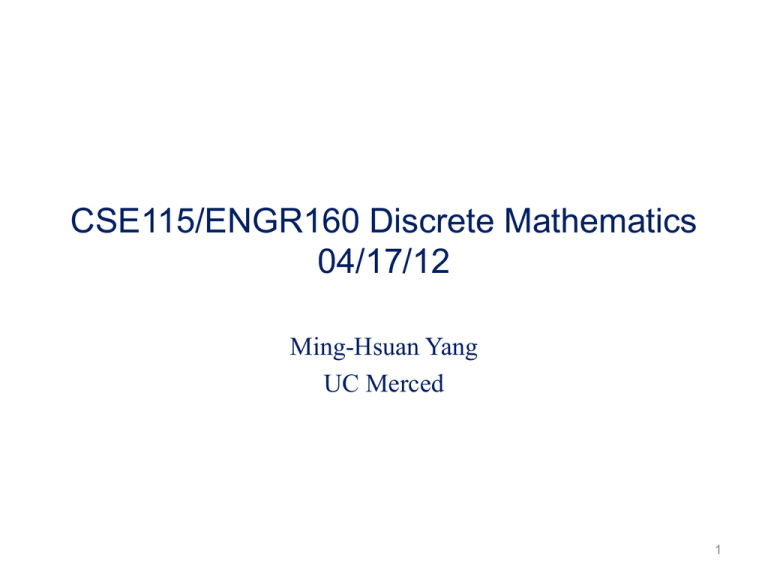
CSE115/ENGR160 Discrete Mathematics
04/17/12
Ming-Hsuan Yang
UC Merced
1
6.3 Permutations & Combinations
• Counting:
– Find out the number of ways to select a particular
number of elements from a set
– Sometimes the order of these elements matter
• Example:
– How many ways we can select 3 students from a
group of 5 students?
– How many different ways they stand in line for
picture?
2
Permutation
• How many ways can we select 3 students from a
group of 5 to stand in lines for a picture?
• First note that the order in which we select students
matters
• There are 5 ways to select the 1st student
• Once the 1st student is selected, there are 4 ways to
select the 2nd student in line. By product rule, there
are 5x4x3=60 ways to select 3 student from a group
of 5 students to stand line for picture
3
Permutation
• How many ways can we arrange all 5 in a line
for a picture?
• By product rule, we have 5x4x3x2x1=120 ways
to arrange all 5 students in a line for a picture
4
Permutation
• A permutation of a set of distinct objects is an
ordered arrangement of these objects
• An ordered arrangement of r elements of a set is
called an r-permutation
• The number of r-permutation of a set with n element
is denoted by P(n,r). We can find P(n,r) using the
product rule
• Example: Let S={1, 2, 3}. The ordered arrangement 3,
1, 2 is a permutation of S. The ordered arrangement
3, 2, is a 2-permutation of S
5
Permutation
• Let S={a, b, c}. The 2-permutation of S are the
ordered arrangements, a, b; a, c; b, a; b, c; c,
a; and c, b
• Consequently, there are 6 2-permutation of
this set with 3 elements
• Note that there are 3 ways to choose the 1st
element and then 2 ways to choose the 2nd
element
• By product rule, there are P(3,2)=3 x 2 = 6
6
r-permutation
• Theorem 1: If n is a positive and r is an integer with
1≤r≤n, then there are
P(n,r)=n(n-1)(n-2)…(n-r+1)
r-permutations of a set with n elements
• Proof: Use the product rule, the first element can
be chosen in n ways. There are n-1 ways to chose
the 2nd element. Likewise, there are n-2 ways to
choose 3rd element, and so on until there are
exactly n-(r-1)=n-r+1 ways to choose the r-th
element. Thus, there are n∙(n-1)∙(n-2)… ∙(n-r+1)
r-permutations of the set
7
r-permutation
• Note that p(n,0)=1 whenever n is a nonnegative
integer as there is exactly one way to order zero
element
• Corollary 1: If n and r are integers with 0≤r≤n, then
P(n,r)=n!/(n-r)!
• Proof: When n and r are integers with 1≤r≤n, by
Theorem 1 we have
P(n,r)=n(n-1)…(n-r+1)=n!/(n-r)!
• As n!/(n-0)!=1 when n is a nonnegative integer,
we have P(n,r)=n!/(n-r)! also holds when r=0
8
r-permutation
• By Theorem 1, we know that if n is a positive
integer, then P(n,n)=n!
• Example: How many ways are there to select a
1st prize winner, a 2nd prize winner, and a 3rd
prize winner from 100 different contestants?
• P(100,3)=100x99x98=970,200
9
Example
• How many permutations of the letters
ABCDEFGH contain string ABC?
• As ABC must occur as a block, we can find the
answer by finding the permutations of 6
letters, the block ABC and the individual
letters, D,E,F,G, and H. As these 6 objects must
occur in any order, there are 6!=720
permutations of the letters ABCDEFGH in
which ABC occurs in a block
10
Combinations
• How many different committees of 3 students can be formed
from a group of 4 students?
• We need to find the number of subsets with 3 elements from
the set containing 4 students
• We see that there are 4 such subsets, one for each of the 4
students as choosing 4 students is the same as choosing one
of the 4 students to leave out of the group
• This means there are 4 ways to choose 3 students for the
committee, where th order in which these students are
chosen does not matter
11
r-combination
• An r-combination of elements of a set is an
unordered selection of r elements from the
set
• An r-combination is simply a subset of the set
with r elements
• Denote by C(n,r). Note that C(n,r) is also
n
denoted by r and is called a binomial
coefficient
12
Example
• Let S be the set {1, 2, 3, 4}. Then {1, 3, 4} is a
3-combination from S
• We see that C(4,2)=6, as the 2-combination of
{a, b, c, d} are 6 subsets {a, b}, {a, c}, {a, d}, {b,
c}, {b, d}, and {c, d}
13
r-combination
• We can determine the number of rcombinations of a set with n elements using
the formula for the number of r-permutations
of a set
• Note that the r-permutations of a set can be
obtained by first forming r-combinations and
then ordering the elements in these
combinations
14
r-combination
• The number of r-combinations of a set with n elements,
where n is a nonnegative integer and r is an integer with
0≤r≤n equals
C (n, r )
n!
r!(n r )!
• Proof: The r-permutations of the set can be obtained by
forming the C(n,r) r-combinations and then ordering the
elements in each r-permutation which can be done in P(r,r)
ways
P(n, r ) C (n, r ) P(r , r )
P(n, r ) n! /(n r )!
n!
C (n, r )
P(r , r ) r! /(r r )! r!(n r )!
15
r-combination
• When computing r-combination
n!
P(n, r ) n(n 1) (n r 1)
C (n, r )
r!(n r )!
r!
r!
thus canceling out all the terms in the larger
factorial
16
Example
• How many poker hands of 5 cards can be dealt
from a standard deck of 52 cards? Also, how
many ways are there to select 47 cards from a
standard deck of 52 cards?
• Choose 5 out of 52 cards: C(52,5)=52!/(5!47!)=
(52x51x50x49x48)/(5x4x3x2x1)=26x17x10x49
x12=2,598,960
• C(52,47)=52!/(47!5!)=2,5,98,960
17
Corollary 2
• Let n and r be nonnegative integers with r≤n.
Then C(n,r)=C(n,n-r)
• Proof:
C (n, r )
n!
r!(n r )!
n!
n!
C (n, n r )
(n r )!(n (n r ))! (n r )!r!
18
Combinatorial proof
• A combinatorial proof of an identity is a proof
that uses counting arguments to prove that
both sides of the identity count the same
objects but in different ways
• Proof of Corollary 2: Suppose that S is a set
with n elements. Every subset A of S with r
elements corresponds to a subset of S with n-r
elements, i.e., A . Thus, C(n,r)=C(n,n-r)
19
Example
• How many ways are there to select 5 players
from a 10-member tennis team?
• Choose 5 out of 10 elements, i.e., C(10,
5)=10!/(5!5!)=252
• How many bit strings of length n contain
exactly r 1s?
• This is equivalent to choose r elements from n
elements, i.e., C(n,r)
20
6.4 Binomial coefficients
• The number of r-combinations form a set with
n elements is often denoted by nr
• Also called as a binomial coefficient as these
numbers occur as coefficients in the
expansion of powers of binomial expressions
such as (a+b)n
• A binomial expression is simply the sum of
two terms, such as x+y
21
Example
• The expansion of (x+y)3 can be found using
combinational reasoning instead of multiplying the
there terms out
• When (x+y)3=(x+y)(x+y)(x+y) is expanded, all
products of a term in the 1st sum, a term in the 2nd
sum, and a term in the 3rd sum are added, e.g., x3,
x2y, xy2, and y3
• To obtain a term of the form x3, an x must be chosen
in each of the sums, and this can be done in only one
way. Thus, the x3 term in the product has a
coefficient of 1
22
Example
• To obtain a term of the form x2y, an x must be chosen
in 2 of the 3 sums (and consequently a y in the other
sum). Hence, the number of such terms is the 3
number of 2-combinations of 3 objects, namely, 2
• Similarly, the number of terms of the form xy2 is the
number of ways to pick 1 of the 3 sums to obtain an
x (and consequently take a y from each of the other
3
two sums), which can be done in 1 ways
23
Example
• Consequently,
( x y ) 3 ( x y )(x y )(x y ) ( xx xy yx yy)(x y )
xxx xxy xyx xyy yxx yxy yyx yyy
x 3 3 x 2 y 3 xy 2 y 3
• The binomial theorem: Let x and y be variables, and
let n be a nonnegative integer
n n j j
( x y ) x y
j 0 j
n
n
n
n n 1 n n
xy y
x n x n 1 y x n 2 y 2
0
1
2
n 1
n
n
n
24
Binomial theorem
n n j j
( x y ) x y
j 0 j
n n n n 1 n n 2 2
n n 1 n n
xy y
x x y x y
0
1
2
n 1
n
n
n
• Proof: A combinatorial proof of the theorem is given. The
terms in the product when it is expanded are of the form xn-jyj
for j=0,1,2…, n
• To count the number of terms of the form xn-jyj , note that to
obtain such a term it is necessary to choose n-j x’s from the n
sums (so that the other j terms in the product are y’s).
n
n
n-j
j
Therefore, the coefficients of x y is
which is equal to j
n j
25
Example
4
( x y ) x 4 j y j
j 0 j
4 4 4 3 4 2 2 4 3 4 4
x x y x y xy y
0
1
2
3
4
4
4
• What is the coefficient of x12y13 in the
expansion of (x+y)25?
25
25!
5,200,300
13 13!12!
26
Example
• What is the coefficient of x12y13 in the
expansion of (2x-3y)25?
25
(2 x 3 y) (2 x) 25 j (3 y) j
j 0 j
25
25
• Consequently, the coefficient of x12y13 is
25 12
25! 12 13
2 (3)13
2 3
13!12!
13
27
Corollary
• Corollary 1: Let n be a nonnegative integer.
Then
n
2n
k 0 k
n
• Proof: Using Binomial theorem with x=1 and
y=1
n
n k nk
n
2 (1 1) 1 1
k 0 k
k 0 k
n
n
n
28
Corollary
• There is also a combinatorial proof of Corollary 1
• Proof: A set with n elements has a total of 2n
different subsets. Each subset has 0 elements, 1
element, 2 elements, or n elements in it. Thus, there
n
n
are 0 subsets with 0 elements, 1 subsets with 1 n
n
n
element, … and n subsets with n elements. Thus k
k 0
counts the total number of subsets of a set with n
elements,
n
n
• This shows that 2n
k 0
k
29
Corollary 2
Let n be a positiveinteger.T hen
n
(1) 0
k 0
k
n
k
n
n
n
k nk
Proof: 0 0 ((1) 1) (1) 1 (1) k
k 0 k
k 0 k
n n n
n n n
0 2 4
1 3 5
n
n
n
30
Corollary 3
Let n be a non - negativeinterger.T hen
n n
2 3
k 0
k
n
k
n
n k nk
n k
P roof: (2 1) 2 1 2
k 0 k
k 0 k
n
n
31
Pascal identity and triangle
• Pascal’s identity: Let n and k be positive integers with n ≥ k.
Then
n 1 n n
k k 1 k
• Combinatorial proof: Let T be a set containing n+1 elements.
Let a be an element in T, and let S=T-{a} (S has n elements)
n 1
• Note that there are k subsets of T containing k elements.
However, a subset of T with k elements either contains a (i.e.,
a subset of k-1 elements of S) or not.
n
• There are k 1 subsets of k-1 elements of S, and so there are n
k 1
subsets of k-1 elements containing a
n
• There are k subsets of k elements of T that do not contain a
n 1 n n
• Thus
k k 1 k
32
Pascal identity and triangle
• Can also prove the Pascal identity with
n
algebraic manipulation of
k
n 1
(n 1)!
k k!(n k 1)!
n
n!
kn!
kn!
k 1 (k 1)!(n k 1)! (k 1)!k (n k 1)! k!(n k 1)!
n
n!
(n k 1)n!
(n k 1)n!
k k!(n k )! k!(n k )!(n k 1) k!(n k 1)!
n n
kn!
(n k 1)n! (k n k 1)n!
(n 1)n!
(n 1)!
k!(n k 1)!
k!(n k 1)! k!(n k 1)!
k 1 k k!(n k 1)! k!(n k 1)!
33
Pascal’s triangle
• Pascal’s identity is the basis for a geometric
arrangement of the binomial coefficients in a triangle
each n - th row, binomialcoefficients
n 1 n n
k k 1 k
n 1 n n
k k 1 k
34
